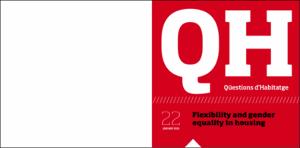Mostra el registre d'ítem simple
Flexibility and gender equality in housing
| dc.contributor.author | Hernández Falagán, David |
| dc.contributor.other | Universitat Politècnica de Catalunya. Departament de Teoria i Història de l'Arquitectura i Tècniques de Comunicació |
| dc.coverage.spatial | east=2.190822400000002; north=41.43239579999999; name=Carrer de Parellada, 11, 08030 Barcelona, Espanya |
| dc.coverage.spatial | east=2.2049727999999504; north=41.4376369; name=Carrer d'Alfarràs, 31, 08030 Barcelona, Espanya |
| dc.coverage.spatial | east=2.204017399999998; north=41.438547; name=Carrer l'Albí, 11, 08030 Barcelona, Espanya |
| dc.coverage.spatial | east=2.191139499999963; north=41.4035057; name=Avinguda Diagonal, 201, 08018 Barcelona, Espanya |
| dc.coverage.spatial | east=2.1187013999999635; north=41.4034348; name=Via Augusta, 403, 08017 Barcelona, Espanya |
| dc.date.accessioned | 2019-07-04T12:05:24Z |
| dc.date.available | 2019-07-04T12:05:24Z |
| dc.date.issued | 2019-01 |
| dc.identifier.citation | Hernández Falagán, D. Flexibility and gender equality in housing. "Qüestions d'Habitatge", Gener 2019, núm. 22, p. 10-54. |
| dc.identifier.issn | 2462-41542 |
| dc.identifier.uri | http://hdl.handle.net/2117/165641 |
| dc.description.abstract | In the introduction to The image of the city1 by American urban planner Kevin Andrew Lynch – who studied users’ experience of spaces – Lynch described the city as an entity whose moving elements are as important as the unmoving physical parts. His point of view is easy to understand if you look at the movement of people, traffic or the activities carried out on the street as being as important as the city’s buildings or fixed infrastructure. The perception of the city not as a physical item but as an organic one that is in constant evolution is very similar to the view we could have of any occupied architectural work, but more particularly of residential ones. In fact, one could define a home as a shared-living group that inhabits a place defined by a set of spaces. This means that spaces are as important in the definition of housing as the functions and uses given to them by their inhabitants. This approach to housing is probably not an original one although, from the architects’ point of view, research has often focused on more 'static' aspects. Some leading architects of the second half of the 20th century, such as Christopher Alexander and N. John Habraken, already developed theories of housing, precisely placing at their centre not the formal conditions of architecture but the uses and occupation of spaces. Alexander’s design patterns or Habraken's theory of supports respectively can be considered two examples of this interpretation. For this reason, in the next few pages we will seek to analyse housing from a dual point of view: paying attention to the easily recognisable spaces that make up a home on the one hand, and considering the more everyday functions and uses that take place in it on the other. In the context of collective housing, it is worth remembering that, for years, successive pieces of housing legislation have been passed resulting in the definition of a set of minimum compulsory physical conditions of habitability. Despite this, legislative efforts have historically focused on a quantitative definition that could explain a set of dimensions regarding health and comfort requirements, adapted to the standard occupancy of a home. This legislation could be considered to be valuable at the times of highest speculative pressure on mass housing production , particularly in the first half of the 20th century – but has proven to be insufficient at times, such as this, of demographic diversity, redefinition of shared-living models or a tendency towards the individual appropriation of spaces. As shown by all the available statistics, neither the family models nor the age at which people access housing, nor the number of occupants in each home, nor even the uses that we demand from current homes, are represented as such in the inherited legislative models. In this context, the legal definition of specific rooms with concrete conditions inevitably leads to a pre-established use for, and appropriation of, each area. In spite of this, such conditioning can be minimised during the design process, and the dimensions and relationships between rooms can be reconsidered in order to give maximum adaptability to spaces and minimise hierarchies when occupying them. For this reason, in this article we will define an interpretation of the concepts of flexibility and adaptability that will be useful when analysing housing. In the final part of this document, we will apply this analysis to a few projects developed in recent years (mainly between 2013 and 2015) by the Barcelona Municipal Institute of Housing and Renovation with the aim of obtaining a diagnosis of the state of this matter and make a few recommendations for improvement. |
| dc.format.extent | 45 p. |
| dc.language.iso | eng |
| dc.rights | Attribution-NonCommercial-NoDerivs 3.0 Spain |
| dc.rights.uri | http://creativecommons.org/licenses/by-nc-nd/3.0/es/ |
| dc.subject | Àrees temàtiques de la UPC::Arquitectura::Tipologies d'edificis::Habitatges |
| dc.subject.lcsh | Dwellings |
| dc.subject.lcsh | Room layout (Dwellings) |
| dc.subject.other | housing |
| dc.subject.other | habitatge |
| dc.title | Flexibility and gender equality in housing |
| dc.type | Article |
| dc.subject.lemac | Habitatges -- Catalunya -- Barcelona |
| dc.subject.lemac | Habitatges |
| dc.subject.lemac | Distribució d'espais (Habitatges) |
| dc.contributor.group | Universitat Politècnica de Catalunya. ACM - Anàlisis Crítiques de la Modernitat: Arquitectura i Ciutat |
| dc.description.peerreviewed | Peer Reviewed |
| dc.relation.publisherversion | https://habitatge.barcelona/sites/default/files/qh22-en-gb_web.pdf |
| dc.rights.access | Open Access |
| local.identifier.drac | 25328166 |
| dc.description.version | Postprint (published version) |
| local.citation.author | Hernández Falagán, David |
| local.citation.publicationName | Qüestions d'Habitatge |
| local.citation.number | 22 |
| local.citation.startingPage | 10 |
| local.citation.endingPage | 54 |
Fitxers d'aquest items
Aquest ítem apareix a les col·leccions següents
-
Articles de revista [187]
-
Articles de revista [90]


